(6) Actions on the Environment and Climate Change
As the environment and climate change are also mentioned in the SDGs, and with the occurrence of extreme weather events and devastating natural disasters in recent years, these are critical time-sensitive issues that the international community must work together on. Japan has been vigorously working on addressing these issues and provides assistance to developing countries through the Global Environment Facility (GEF),* a financing mechanism for major international environmental treaties such as the Convention on Biological Diversity and United Nations Framework Convention on Climate Change (UNFCCC), as the world’s top donor.
● Japan’s Efforts
■ Conservation of the Marine Environment
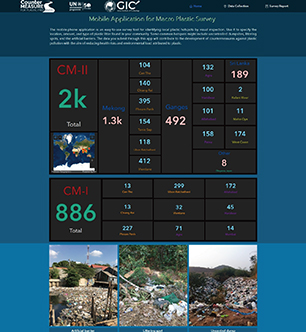
The status of plastic leakage made available on a dedicated website by UNEP’s countermeasure projects against marine plastic (Photo: UNEP)
Marine plastic litter is a pressing issue that can have an adverse impact on the marine ecosystem, tourism, fisheries, and human health. In recent years, measures to address this issue have become increasingly important. As of December 2021, 87 countries and regions have shared the “Osaka Blue Ocean Vision,” which aims to reduce additional pollution by marine plastic litter to zero by 2050, and was led by Japan at the G20 Osaka Summit in 2019. In order to realize the Vision, Japan launched the “MARINE Initiative” that focuses on (i) Management of wastes, (ii) Recovery of marine litter, (iii) Innovation, and (iv) Empowerment. Under the Initiative, Japan supports capacity building and infrastructure development for waste management in developing countries in order to encourage effective measures against marine plastic litter worldwide (see also “Master Techniques from Japan to the World 3” for efforts on the formation of a Center of Excellence for Marine Plastic Pollution Studies in Thailand).
In 2021, Japan provided support through the United Nations Environment Programme (UNEP) for the projects for marine plastic countermeasures implemented by UNEP’s Asia and Pacific Office, which conducted awareness-raising activities for local people and developed a method for monitoring the flow of plastics into the ocean in the lower Mekong River basin of the Indochinese Peninsula as well as the Southwest Asia region. In addition, in order to enable policy making informed by scientific evidence, sampling surveys of plastic litter and scientific analysis of pathways of plastic pollution have been conducted to formulate policy recommendations and guidelines based on the results. Furthermore, in collaboration with a Japanese IT company, a plastic leakage hotspot map was created, identifying approximately 3,000 leakage points, and released on a dedicated website Note 62 available to the general public.
Moreover, as part of expanded assistance for ASEAN to address marine plastic litter issues that was announced at the ASEAN-Japan Summit Meeting in 2018, Japan has provided capacity building support and conducted awareness-raising and public relations activities for environmental conservation primarily on reducing marine plastic litter in ASEAN countries since 2019.
For example, since 2021, with the contributions of the Japan-ASEAN Integration Fund (JAIF), Note 63 Japan has supported capacity building for marine litter reduction by producing television programs on marine plastic litter issues, assisting in the promotion of a plastic circular society, and providing assistance for the formulation of national action plans for ASEAN countries. Concerning ODA projects, a total of eight participants (two from Thailand and one each from Cambodia, Indonesia, Laos, Malaysia, Myanmar, and Viet Nam) participated in online training held in January and November 2021. In the first training session, participants learned about survey methods and analysis techniques. In the second session, they learned about the efforts of companies, local governments, and communities to promote the recycling of marine plastic litter in Japan.
■ Conservation of Marine Resources
Japan has conducted training and workshops on countermeasures against illegal, unreported, and unregulated (IUU) fishing through JICA with the cooperation of the Southeast Asian Fisheries Development Center (SEADEC). Curbing the impact on fish ecosystems affected by IUU fishing that exceeds regulatory thresholds will lead to supporting the sustainability of the fishing industry, one of the core industries for ASEAN countries, and the sustainable development of fishing communities.
■ Climate Change

Prime Minister Kishida giving a speech at the COP26 World Leaders Summit in November 2021 (Photo: Cabinet Public Affairs Office of the Government of Japan)
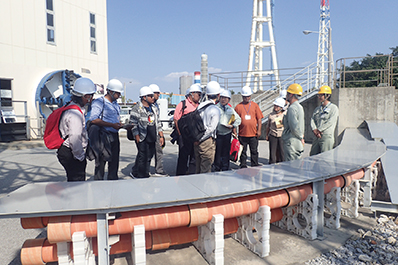
Training participants in “The Project for Introduction of Hybrid Power Generation System in the Pacific Island Countries” visiting the Okinawa Electric Power Company’s training facility in Japan and receiving a lecture (Photo: Okinawa Enetech)
Climate change is a global issue that requires a cross-border approach, which calls on the international community including both developed and developing countries to strengthen its concerted efforts. The Paris Agreement was adopted at the 21st Session of the Conference of the Parties to the United Nations Framework Convention on Climate Change (COP21) (2015), as a framework under which all countries would work toward greenhouse gas (GHG) emission reductions. The Paris Agreement entered into force in 2016.
In October 2020, as attention focused on sustainable and resilient recovery following the spread of COVID-19, Japan announced its goal of achieving net-zero GHG emissions by 2050. In April 2021, Japan also announced its aim to reduce its GHG emissions by 46% in FY2030 from its FY2013 levels, and to continue strenuous efforts in its challenge to meet the lofty goal of cutting its emissions by 50%. In October 2021, Japan submitted its Nationally Determined Contribution (NDC) Note 64 reflecting these goals and “The Long-term Strategy under the Paris Agreement” to the United Nations (see “ODA Topics 4” for Japan’s efforts in aiming to achieve a carbon-neutral society).
COP26 was held in Glasgow in the United Kingdom from October 31 to November 13, 2021, after being postponed due to COVID-19. At COP26, the rules for Article 6 (market mechanisms) of the Paris Agreement were adopted, for which there had been ongoing negotiations, based on Japan’s proposal, as well as on the reporting format for GHG emissions and NDC progress by each country and common time frames for NDC implementation. With the completion of “the Paris Rulebook,” important progress has been made in steadily implementing the Paris Agreement and promoting climate change countermeasures throughout the world.
Japan is actively supporting climate change actions in developing countries. At the G7 Cornwall Summit held in June 2021, Japan announced its support related to climate change, both public and private, totaling ¥6.5 trillion over the five-year period from 2021 to 2025, and its further enhancement of assistance for adaptation Note 65 for countries vulnerable to the impacts of climate change.
Furthermore, on November 2, Prime Minister Kishida attended the World Leaders Summit, the summit-level meeting of COP26, and announced Japan’s efforts to promote future climate change actions. In regard to support for developing countries, in addition to the support announced at the G7 Cornwall Summit in June, he announced that Japan would provide up to $10 billion in both public and private finance over a five-year period. Prime Minister Kishida also announced the doubling of Japan’s amount of assistance for adaptation to climate change from the previous commitment (ACE 2.0) to ¥1.6 trillion over five years.
Regarding multilateral support, Japan has supported developing countries through its contribution to the Green Climate Fund (GCF),* the world’s largest multilateral climate fund. Japan has pledged up to $3 billion to the fund, putting effort into supporting countries vulnerable to the impacts of climate change as the fund’s second largest donor country. At the GCF, a total of 190 projects have been approved by December 2021, with a large number of them entering the implementation phase, which in total are expected to avoid GHG emissions by 2 billion tons and increase the resilience of 610 million people through support for adaptation. Additionally, from Japan, JICA, MUFG Bank, and SMBC have been approved as “Accredited Entities” that are entitled to propose GCF projects, and to date, two projects by MUFG Bank (construction of solar power and pumped-storage hydroelectricity facilities in Chile (July 2019) and sustainable forestry project in seven countries in Sub-Saharan and South American region (March 2020)) and two projects by JICA (Community-based Landscape Management for Enhanced Climate Resilience and Reduction of Deforestation in Critical Watersheds (March 2021) and Building Climate Resilient and Safer Islands in the Maldives (July 2021)) have been approved.
Furthermore, in order to achieve net-zero GHG emissions for the international community as a whole, at the annual meetings of the World Bank and IMF in October 2021, Japan released “Japan’s Proposal on MDBs’ Support in the Energy Sector.” The proposal requests multilateral development banks (MDBs) to support developing countries in formulating and implementing ambitious energy plans, as well as the best projects from the perspective of reducing GHG emissions.
In line with this proposal, Japan cooperates with MDBs to support efforts to bolster energy transition in developing countries. This includes contribution to the establishment of the Asian Development Bank’s (ADB) Energy Transition Mechanism (ETM), which supports the energy transition from coal-fired power generation in developing countries, and the Capital Market Mechanism of the Climate Investment Fund instituted at the World Bank, at COP26.
As a specific example of bilateral assistance, Japan has supported the establishment of the Pacific Climate Change Centre in Samoa to which Japan dispatches experts on climate change countermeasures. Through the Centre, Japan strives to develop human resources in the Pacific Island countries vulnerable to climate change (see also “Stories from the Field 4”).
In addition, as part of its assistance for climate change actions in developing countries and others, Japan promotes the “Joint Crediting Mechanism (JCM),”* which facilitates the global diffusion of advanced decarbonizing technologies to the world including to developing countries. This will contribute to GHG emission reductions in developing countries and Japan, and partner countries can share the result as credits. In 2013, Japan signed the first bilateral document pertaining to the JCM implementation with Mongolia, and to date, it has established the JCM with 17 countries. As of the end of 2021, the JCM credits have been issued from 38 energy-saving and renewable energy projects in Cambodia, Indonesia, Kenya, Laos, the Maldives, Mongolia, Palau, Saudi Arabia, Thailand, and Viet Nam. These JCM projects are contributing to GHG emission reductions worldwide.
As countries, particularly those in Asia, declared net-zero GHG emissions at COP26, it is important for Japan to support decarbonization transitions throughout the world. Japan implements comprehensive cooperation for decarbonization transitions in the ASEAN region based on the ASEAN-Japan Climate Change Action Agenda 2.0 announced by Prime Minister Kishida at the ASEAN-Japan Summit Meeting held on October 27, 2021.
Japan will continue to lead the international community toward the realization of a decarbonized society, which is the goal of the Paris Agreement.
■ Biodiversity
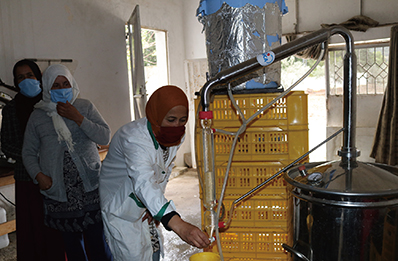
Extraction of essential oils at an agricultural cooperative in Tunisia. Through ODA loans, Japan supports forest restoration, sustainable forest management, and improvement of the natural environment (Photo: JICA)
Expansion in the types, scope, and scale of human activities has given rise to serious concerns about further degradation of habitats and the destruction of the ecosystem in recent years. Japan values biodiversity initiatives, as seen in the 10th Meeting of the Conference of the Parties to the Convention on Biological Diversity*(COP10) (2010) in Nagoya City, Aichi Prefecture. With the aim of providing support such as the capacity building of developing countries toward the achievement of the Aichi Biodiversity Targets, Note 66 Japan has made contributions to the Japan Biodiversity Fund, Note 67 through which the Secretariat of the Convention organizes webinars on the conservation of biodiversity. The first part of the 15th Meeting of the Conference of the Parties (COP15), which had been postponed due to COVID-19, was held in October 2021, and its second part is scheduled to be held in 2022. During the first part, Minister of the Environment Yamaguchi announced Japan’s international support as the second phase of the “Japan Biodiversity Fund” with $17 million in total. During the second part of COP15, the formulation of the Post-2020 Global Biodiversity Framework is expected, including the next global goals and targets that will replace the Aichi Biodiversity Targets. Japan participates in and contributes to the discussions.
In recent years, illegal trade of wildlife has increasingly become a serious issue. The international community has been paying attention to this issue as it has been one of the funding sources of international terrorist organizations. Along with actively participating in the discussions at the Convention on International Trade in Endangered Species of Wild Fauna and Flora (CITES), Japan works on resolving these issues in cooperation with the international community through the contribution to projects implemented by the CITES Secretariat. Specifically, Japan has supported the construction of facilities for implementing elephant poaching countermeasures among other initiatives.
■ Conservation of Tropical Forests
Tropical forests account for approximately half of the world’s forests and play an important role in tackling climate change and conserving biodiversity. Japan invited the International Tropical Timber Organization (ITTO) to establish its headquarters in Yokohama, and has supported sustainable management of tropical forests as well as legal and sustainable tropical timber trade through the organization for more than 30 years. In recent years, through voluntary contributions from Japan, ITTO has been engaged in projects to deal with forest fires in the tropics, which have become more frequent and serious recently, projects to build capacity for sustainable forest management in tropical timber producing countries, and the development of a timber-tracking system to combat illegal logging (see also “Project Introduction Column”).
■ Environmental Pollution Control Measures
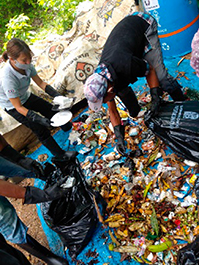
A JOCV working to help improve recycling rates in the Dominican Republic (Photo: JICA)
In developing countries, regulatory controls on hazardous chemical materials are often not in place, and sometimes lead to environmental pollution and health damage. Japan has accumulated abundant knowledge, experience, and technology related to environmental pollution control measures and utilizes them to solve environmental pollution problems in developing countries (see “Stories from the Field 5” regarding efforts for environmental conservation and ecotourism by former JICA training participants in Bolivia). Japan also conducts technical cooperation in the chemical industry, such as dispatching experts to developing countries and accepting trainees from them, including in the areas of environmental management techniques, analysis techniques and risk evaluation for environmentally hazardous substances, and chemical trace analysis techniques.
The “Minamata Convention on Mercury” was adopted at the Conference of Plenipotentiaries on the Minamata Convention on Mercury (2013) and entered into force in August 2017. Japan exercises continuous leadership in promoting the management of global mercury pollution by proactively transferring to the world its technology and know-how on preventing adverse effects caused by mercury, accumulated through its experience with the Minamata disease. Note 68 In December 2021, Japan, among other things, held online training regarding the monitoring of mercury with the participation of 33 countries and regions, partnering with UNEP-ROAP as the implementing institution in order to provide support for developing countries.
In the field of waste management, based on the “MARINE Initiative,” Japan announced to provide training for 10,000 officials engaging in waste management around the world by 2025, and approximately 6,000 officials have been trained by the end of 2021.
Moreover, as a model project for waste management support in Africa under the African Clean Cities Platform (ACCP),* Japan has provided support for the Hulene final waste dumping site in Mozambique. Following an accident in which a waste pile collapsed due to heavy rains, Japan has supported the prevention of further collapse and future safety measures by applying the “Fukuoka method” at the dumping site through pilot construction utilizing counterpart funds and on-site guidance by experts. This “Fukuoka” method was developed by Japan and is being introduced in waste dumping sites around the world, such as Asia and Africa. The first construction for safety measures, which began in 2019, was completed in October 2020.
Indonesia, Peru
Prevention and Management of Fires in Tropical Timber Production Forests
ITTO Contributions (February 2021 – January 2022)
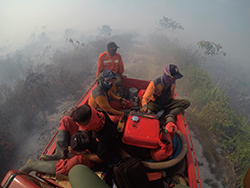
Members of the Forest and Land Fire Brigade going to the scene of a fire in West Kalimantan Province, Indonesia (Photo: Ministry of Environment and Forestry of the Republic of Indonesia)
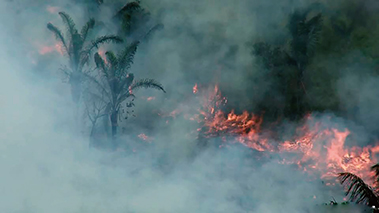
Fighting a forest fire in the Department of Junín, Peru (Photo: National Forest and Wildlife Service of Peru)
The International Tropical Timber Organization (ITTO) is an international organization promoting the sustainable forest management of tropical forests and the expansion and diversification of trade in legally harvested tropical timber. Under the auspices of the United Nations Conference on Trade and Development (UNCTAD) and with the strong support of the Government of Japan and Yokohama City, it was established in 1986 and headquartered in Yokohama. The importance of ITTO’s work has risen amid progressive rises in global temperatures and growing expectations on the role of forests in mitigating climate change through the absorption of greenhouse gases. The ITTO staff, nearly half of which are Japanese, are involved in a variety of assignments from project management to finance and general affairs.
The ITTO has a track record of policy formulation and capacity building related to integrated forest fire management*1 in tropical regions. As a part of these initiatives, with the support of the Government of Japan, ITTO assisted Indonesia*2 and Peru*3 in 2021 in conducting projects that take an integrated and participatory approach to forest fire management.
Prolonged droughts and heat waves aggravate forest fires, and these are major causes of deforestation and forest degradation in Kalimantan and the Amazon region. The two projects targeted both regions, which are particularly vulnerable to forest fires, and carried out promotional campaigns and training for indigenous people (particularly those who engage in practices such as slash-and-burn agriculture), community residents (including farmers), and other relevant forestry stakeholders. This training promoted awareness of the importance of the sustainable use of forest resources and the prevention and management of fires in agriculture and forestry practices. Furthermore, the project strengthened the capacity of firefighting-relevant authorities, introduced early-warning alert and fire monitoring systems leveraging information and communications technology (ICT), and enhanced cooperation networks to facilitate information exchange and dialogue among all relevant local stakeholders (including local residents, forestry workers, NGOs and local and central institutions) for forest fire prevention. As of December 2021, four training courses have been conducted for community residents tasked with fire management and a guidebook about appropriate forms of agricultural waste processing is in the final stages of completion. These activities, combined, provide local communities with the means to sustain livelihoods through more sustainable methods.
These projects are expected to help manage forest fires appropriately and conserve tropical forest resources in Kalimantan and the Amazon region, thereby contributing to climate change mitigation and biodiversity conservation.
*1 Integrated forest fire management (IFFM) is a systematic approach to manage forest fires. In addition to the traditional efforts of fire prevention and fire extinction, it includes the implementation of planned burns as one of the means, resident participation, and forest law enforcement.
*2 South Sumatra Province, Central Kalimantan Province, and South Kalimantan Province.
*3 Department of Cajamarca, Department of Huánuco, Department of Junín, Department of Pasco, and Department of Ucayali.
Glossary
- Global Environment Facility (GEF)
- A multilateral funding mechanism providing primarily grant-based financing for projects that contribute to global environmental conservation in developing countries. Established in 1991, 184 countries including Japan participate (as of December 2021). The World Bank manages the contributions from participating countries. Through 18 implementing organizations including MDBs (World Bank, ADB, etc.) and UN organizations (UNDP, UNEP, etc.), it assists in the five areas of biodiversity conservation, measures against climate change, pollution prevention in international waters, measures against land degradation, and measures against chemicals and waste. It is designated as the financing mechanism to five international conventions: United Nations Framework Convention on Climate Change, Convention on Biological Diversity, UN Convention to Combat Desertification, Stockholm Convention on Persistent Organic Pollutants, and Minamata Convention on Mercury.
- Green Climate Fund (GCF)
- A multilateral climate fund established by the decision of COP16 (Cancun Agreement) in 2010, in order to support developing countries in reducing/absorbing their GHGs (mitigation) and enhancing their ability to respond to climate change (adaptation).
- Joint Crediting Mechanism (JCM)
- A mechanism to evaluate contributions from Japan to GHG emission reductions or removals in a quantitative manner achieved through the diffusion of advanced decarbonizing technologies, products, systems, services, and infrastructure to developing countries and others and through the implementation of GHG reduction projects, and to use the achieved reductions as “credit” to achieve Japan’s emission reduction target.
- Convention on Biological Diversity (CBD)
- A convention adopted in 1992 to advance efforts to address biodiversity issues on a global scale. The objectives of CBD are the following: (i) conservation of biological diversity, (ii) sustainable use of the components of biological diversity (utilizing living things, etc. for resources into the future while maintaining diversity at the levels of ecosystems, species, and genes), and (iii) fair and equitable sharing of the benefits arising from the utilization of genetic resources. Through the provision of economic and technical assistance to developing countries from developed countries, the international community as a whole facilitates the conservation and sustainable use of biological diversity worldwide.
- African Clean Cities Platform (ACCP)
- Established in 2017 by the Ministry of the Environment together with JICA, the City of Yokohama, UNEP, and the UN Human Settlement Programme (UN-Habitat) aiming to share knowledge on waste management and promote the achievement of the SDGs in Africa. 89 cities in 42 countries in Africa have joined, holding plenary sessions, creating various guidelines and educational materials, planning study tours, and more.
- Note 62: “Mobile Application for Macro Plastic Survey” (https://arcg.is/1DOOWW)
- Note 63: See Note 4.
- Note 64: Parties set their GHG emission reduction targets and formulate measures to achieve them, which are submitted as their NDC to the United Nations Framework Convention on Climate Change (UNFCCC) secretariat.
- Note 65: There are two strategies to tackle climate change. The first is “mitigation,” which refers to reducing GHG emissions through energy conservation, the use of low-carbon energy such as renewable energy, and carbon dioxide absorption by plants. The second is “adaptation,” which refers to the prevention and alleviation of negative impacts being brought about by climate change such as sea level rise and drought.
- Note 66: Set out in the Strategic Plan for Biodiversity 2011 - 2020 of the CBD adopted at COP10 in 2010.
- Note 67: Established in the Secretariat of the CBD by Japan during its COP10 Presidency with the aim of cultivating capacities in developing countries for the achievement of the Aichi Biodiversity Targets.
- Note 68: A toxic nervous disorder caused by ingesting fish and shellfish contaminated with methylmercury compounds discharged from chemical plants. The disease was officially acknowledged in May 1956 in and around Minamata Bay area in Kumamoto Prefecture, and in May 1965 in the Agano River basin of Niigata Prefecture.
